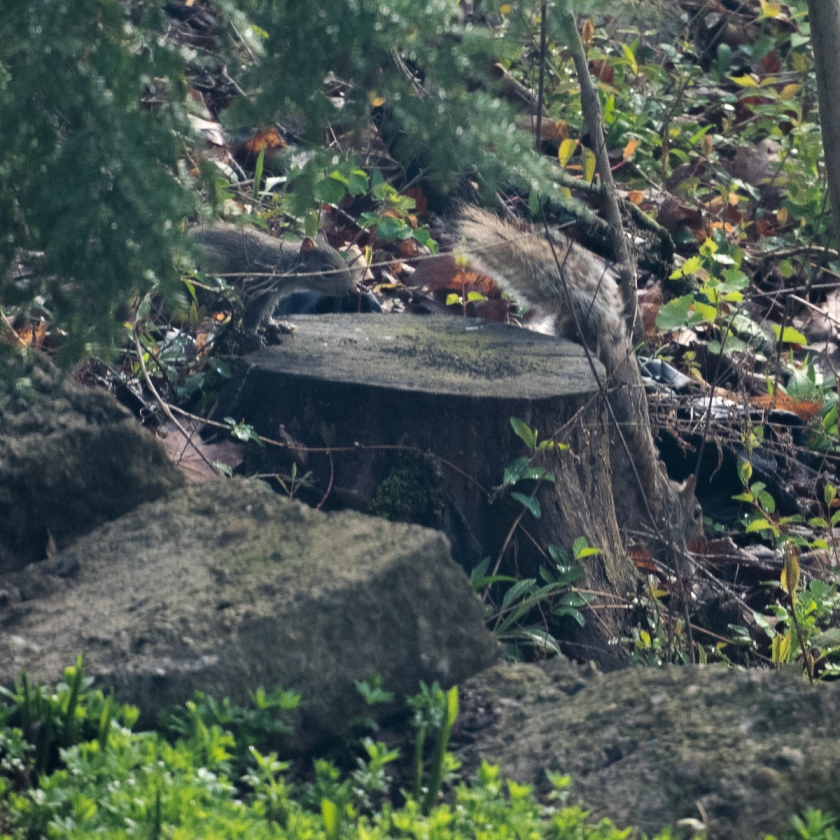I posted my pictures of the eagle and nest at Carrillon Park in Dayton, Ohio at christinemgrote.com. Please follow me there.
Photographing the Hawks’ Nest
I put up a new post on the blog at christinemgrote.com today. Please follow me there and unfollow me here. I’d like to put future posts at christinemgrote.com and use this site for archives only.
Two Hawks and a Nest
I know it’s been a while. Let’s not talk about it. No excuses.
My goal is to eventually post only from my christinemgrote.com site and keep this blog as an archive only. If you are seeing this because you’ve followed this blog years ago, (and I truly thank you for that) I hope you will follow me there. If I continue on this course, you probably won’t be bothered with a lot of notifications in your inbox.
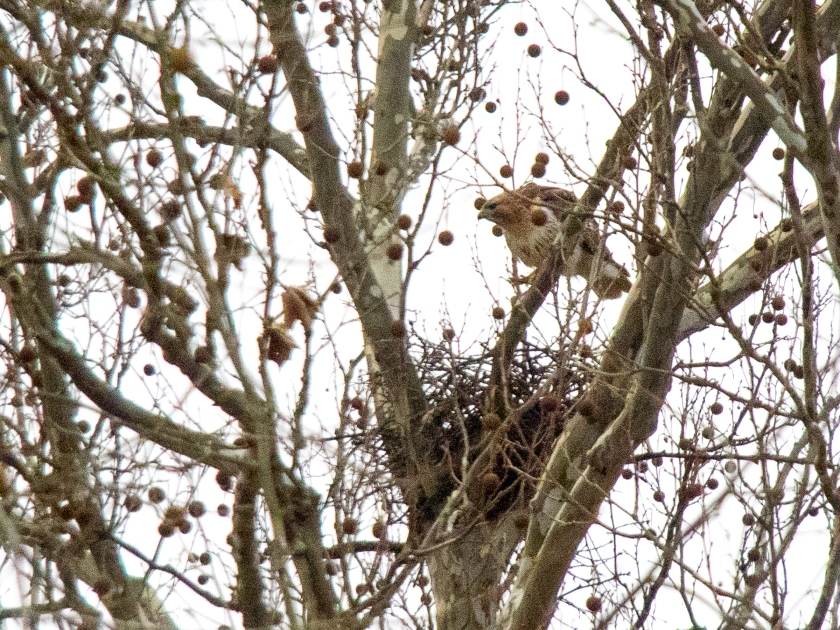 I’m back to bird-watching. I haven’t done a bird-watching post since I watched the little hummingbird in June of 2016. It’s not that I decided it was time. It’s just that I noticed the two large hawks flying around the treetops of our woods. Read more at christinemgrote.com.
I’m back to bird-watching. I haven’t done a bird-watching post since I watched the little hummingbird in June of 2016. It’s not that I decided it was time. It’s just that I noticed the two large hawks flying around the treetops of our woods. Read more at christinemgrote.com.
Sun rays
I’m writing this post just so you know I’m still alive, although not writing much of anything.
I figured out how to photograph sun rays a few days ago, completely by accident. Mark was in the process of trying to contain an aggressive fire he had started while burning leaves at the edge of the woods. (He adamantly maintains it was always under control.) I was trying to prevent him from burning the woods to the ground. Sometimes beautiful things happen from unexpected circumstances.
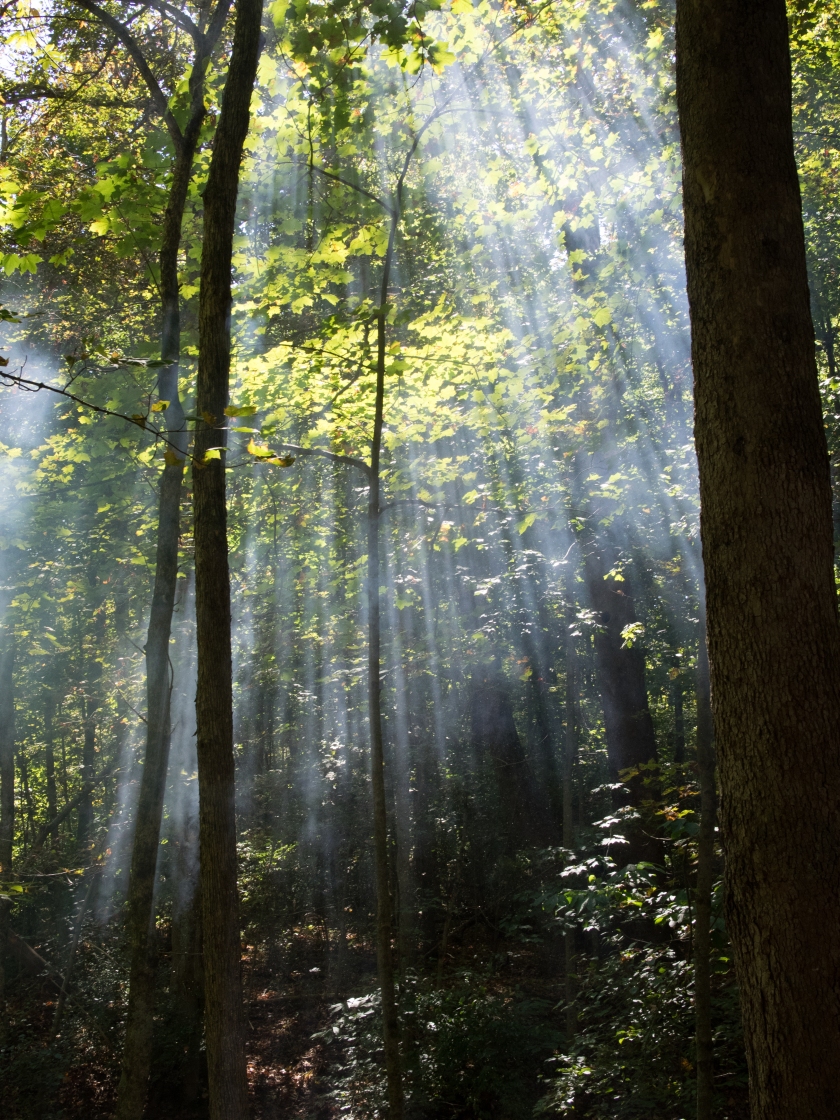
The Empty Nest
There’s a bird’s nest inside this birdhouse outside my window.
Today I sit and watch as two little wrens go in and out. They fly away, return, then leave again. There are chicks in that nest, I think.
I marvel at the energy and devotion of the two parents, for both of them are involved in the feeding of these babies. Their search for food on endless flights seems to occupy every single moment of the day. Hard workers, are these little birds. And demanding are the babies.
One day, and I likely won’t see it happen, the babies will leave the nest to fly away, as will the parents. The nest will sit empty inside the birdhouse for weeks, months, nearly a year I suppose, until the next breeding season.
What will those hard-working parents do? How will they spend their time now? Do they realize it is but a reprieve until next season, next year, when they will be back at this hard work again? Or perhaps, with a limited view of time cycles and the future, do they fly away with a song, set free at last?
In either case, I suspect they rest, and play, if birds can play. Maybe they soak in the sun on their backs, ruffle their feathers in a soft breeze, and drink in the fresh and cool summer rains.
Our children have left this nest, but we have not. We are still here. But the nest feels empty now with the cessation of incessant needs, and the purpose that energized our flights back and forth dissipated.
How will we spend our our time now?

My own home town
I was born in a small town near the middle of Ohio along the I-75 corridor, north of Dayton, south of Toledo, called Piqua. My parents, and their parents, and grandparents, and further on back in their genealogy lived in Piqua. Most who immigrated here from Germany, or Ireland, or England, settled in Piqua and established homes and families. Many are buried in Forest Hill Cemetery along the river in the north section of town.
In March of 2011, I wrote about my memories of growing up in Piqua.
Even back in the 1950s, it wasn’t easy to find a job in a small town. When my dad returned from the service in the mid-1950s, he started working for NCR in Dayton, Ohio, about an hour’s drive away. In the 60’s my parents packed up our bags and moved us there. Neither my mom or dad really wanted to go. My mom didn’t work outside the home. All her family and friends were in Piqua. Over the years, my dad made no secret of the fact that he always missed Piqua. My parents had conversations about moving back “home” during their retirement years. They finally made it back in January of 2013, when they were both buried in Forest Hill Cemetery.
I understand the allure of small town life.
So, this morning, as I watched a CNN report on Beattyville, a small town in Kentucky where people are struggling to get by, it brought me to tears. I am a small-town girl at heart.
But sometimes you have to move. Times change. Opportunities shift. Throughout history we can find example after example of towns and cities that once prospered but then failed. The Dust Bowl comes to mind (probably because I just watched the documentary on Netflix). Sometimes we see cities that came through a rough patch and are beginning to thrive again. Buffalo, NY, is a good example. Buffalo was a rich city at one point during the height of waterway commerce. Then other forms of transportation developed and Buffalo was left with empty grain silos decomposing along its riverfront. The good news is that Buffalo is finding a way to reinvent itself. It is finding a way to thrive in the country and world as it is today.

My husband, Mark, and I visited Bakum, Germany last summer. It’s a small agricultural town in northern Germany about a half-hour’s drive south from Bremen. We’ve traced Mark’s ancestors back to Bakum from 1530 until 1850, when they emigrated to Amerika. In some ways, you could argue that Bakum is Mark’s family’s “hometown.” Certainly it was his great-grandfather’s.
In the early 1800s, the population in Bakum grew at a fast rate and the farming communities became over-crowded. People were living in barns, sheds, bake houses, in any available structure they could find. There was no food to eat. Parents struggled to provide shoes for their children. Poverty was rampant. Mark’s ancestor, Bernard Dominicus Grote, lived in the farming community of Elmelage and worked as a hired hand on land owned by the Knese family. Dominicus’ brothers all lived nearby on other farms. They all went to St. John the Baptist, the small church in town. I’m sure they did not wish to leave their family, their hometown and their homeland to come to a strange country with a language they couldn’t understand.
But they did. Like other ancestors of probably most, if not all of us.
I’m not talking about immigration right now. I’m talking about people following opportunity and doing what they need to do to survive. There is nothing new about this. It is the story of human survival from the beginning of time.
I truly hope our country can find a way to make things better for the folks in small towns who have lost their local industries and jobs. No one wants to see people suffer like that. But I also believe the way forward is exactly that, forward. Not back.
~~~~~
While we WERE watching
Although I feel fortunate, as I wrote in my last post, “to witness some of the wildlife here that shares this woods and this planet with us,” sometimes I see things I wish I hadn’t.
I regret to tell you my hummingbird story does not have a happy ending.
After watching the little hummingbird work nonstop building her nest over Memorial Day weekend, on Tuesday when I had breakfast, she was sitting on the nest.
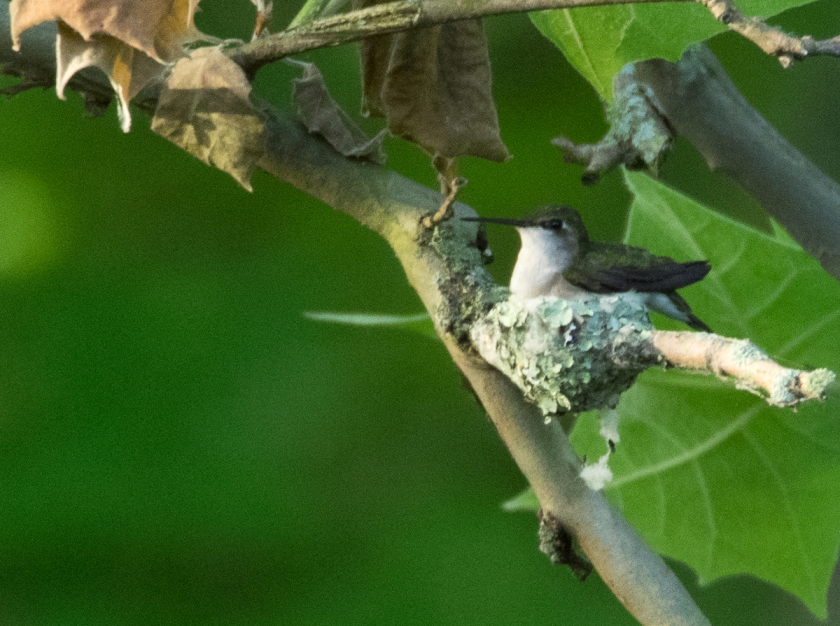
And like the article I read at rubythroat.org, she sat on the nest most of the day, leaving it occasionally for short trips. She did fuss with the nest from time to time, but I felt certain she had laid her eggs.
As I came to find out, her job of bringing hummingbird chicks into the world was more challenging than just incubating the eggs. One occasion when she had left the nest, I spied a blue jay on the branch just below her nest. Then he hoped up on the adjacent branch. I feared he was going to take the eggs, so I banged on the window, then opened it and yelled, and then went outside adding arm motions to my voice. That scared the blue-jay away, this time, but I knew I was not going to be able to guard those eggs all day long. And without a bb-gun or a slingshot, I wasn’t well-positioned to protect the nest. I knew the hummingbird was on her own.
By the end of the day, the mother was sitting on the nest, doing her thing. She had made it through day-one. Only 13 to 15 more days to go.
On Wednesday she was doing a good job of guarding her eggs. At one point in the day, I saw her come back to the nest and she was flying like a crazy bird up and down, back and forth, near the nest. When I looked closer, I saw another bird very near the nest. With that long beak, hummingbirds can be pretty intimidating, I imagine. She successfully chased the intruder off and went back to the work at hand.
Thursday morning at breakfast, I heard Mark say, “Oh no! He got the egg.” He rushed towards the door. I looked out the window and saw a big blue-jay dip its beak into the nest and come out with what looked like a little white pea or pebble. He got both eggs.
I wondered what the little hummer would do when she returned. At first she just sat on the nest. I don’t think she realized the eggs were gone initially. She couldn’t settle into the nest, but kept shifting and moving around.

Then she got up and started looking into the nest.
She sat back on the nest at one point.

Then she looked in the nest some more. It looked like she cleaned something out of it at one point, maybe a piece of eggshell.
She flew away briefly and came back. I read that hummingbirds have two broods and sometimes use the same nest. I wondered if she was cleaning things up to come back and try again.
By 8:03, just a few minutes after the theft of her eggs, the little hummer left the nest. We haven’t seen her since.
While we’re not watching
The backyard drops away from where our house sits on the hill. Because of that, our view from our windows is at, if not treetop level, certainly a tree-house level. From the bay windows around our kitchen table, I can watch birds while I eat. Since I spend a fair amount of time doing that on a daily basis, I witness things in the woods I might miss were I not watching.
Like this little hummingbird, for example.
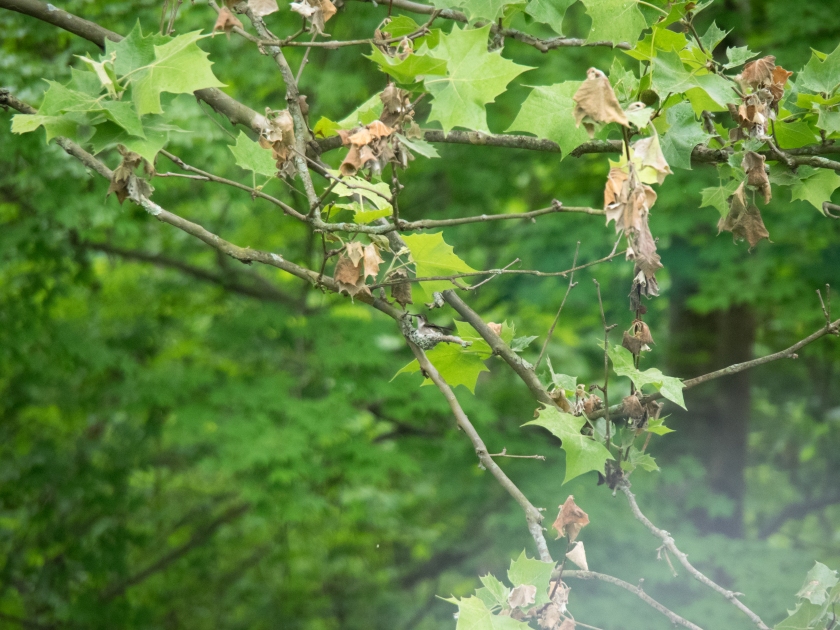
“That little bird really likes to land at that spot,” I said to Mark. “I’ve seen it in that same exact spot several times in the past couple of days.”
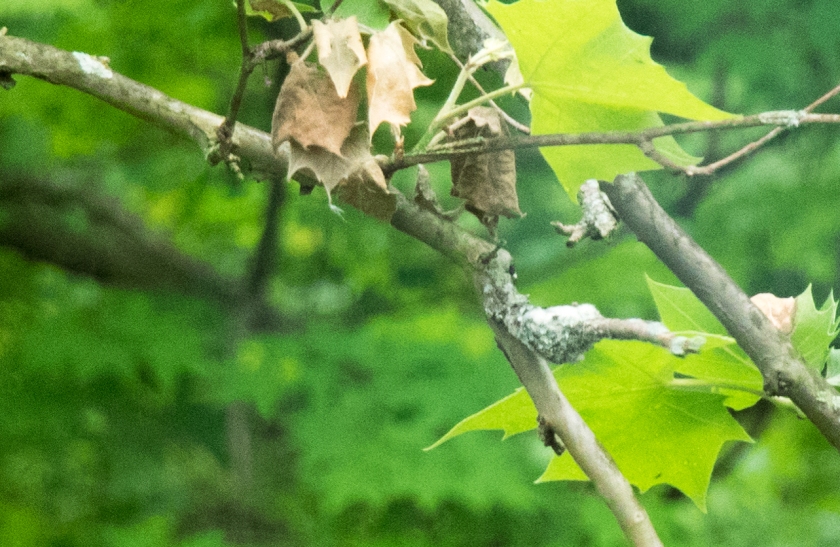
I wanted to get it’s picture so I zoomed in with my camera, but the little lady wasn’t there.
I didn’t realize it immediately, but you may have guessed. She was making a nest.

It looks more like a nest when she is sitting on it.
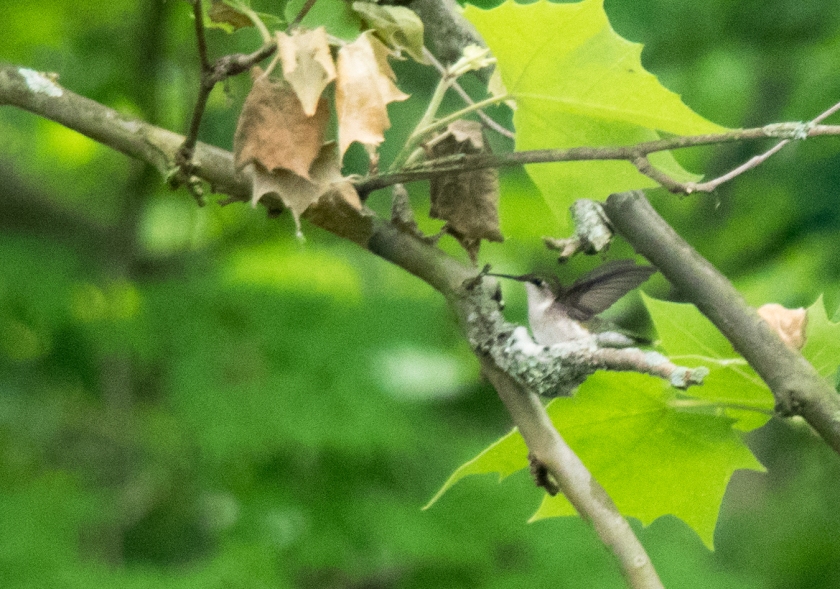
She doesn’t rest there long.
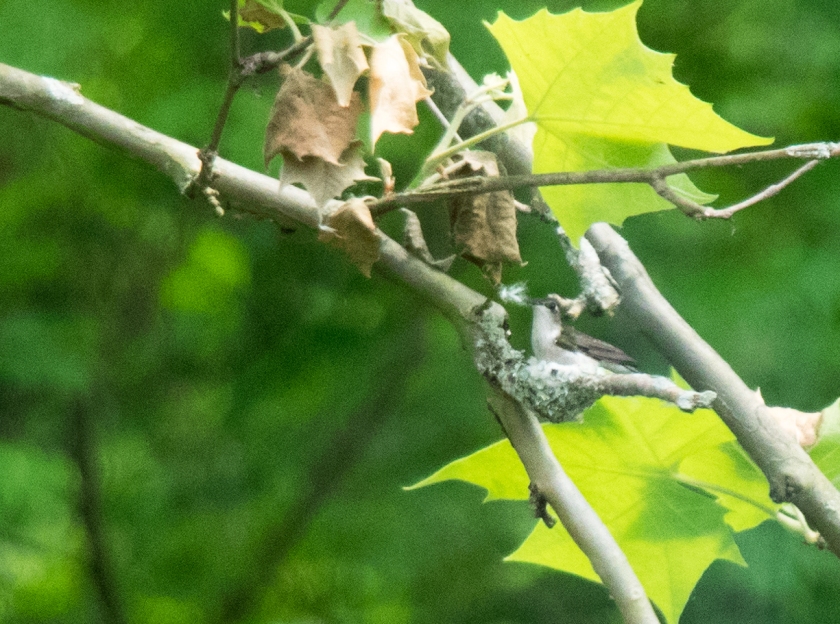
She’s busy scavenging building materials like cottonwood seeds,
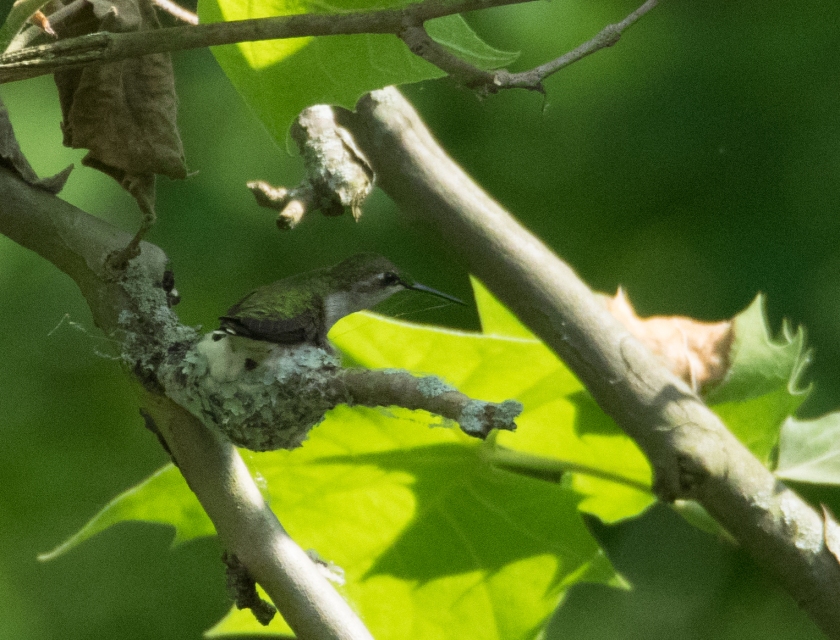
or spider webs, that you can just barely see if you look below her beak.

Then she has to tuck everything into the nest she’s building.

By the end of the day, she had made the nest cozy and comfortable with the soft white cottonseeds.

I don’t know if she spent the night there or not.
According to rubythroat.org, after the hummingbirds mate, the male and female have little or nothing to do with each other. She will be a single parent. A day or two after her nest is complete, she will lay two pea-sized eggs. Occasionally there may be only one, but she knows better than to try to manage feeding three on on her own—so usually only two.
Incubation lasts about two weeks. I should be able to tell because during this time period she will be on the nest 50 to 55 minutes every hour.
When the chicks hatch they are about 2 cm in length and not able to keep their bodies warm. The mother still stays with them, but leaves the nest for quick trips to find food which may be nectar, pollen, and tiny insects.
The chicks will stay in the nest about three weeks.
I’m really hoping to shoot a photo of the mother feeding the babies.
After dinner, Mark and I sat on our screened in porch, also at tree-house level. We saw a young doe, and then later a young buck, wander along the creek just inside the woods at the bottom of our yard. We listened to bird calls, occasionally hearing one we didn’t recognize. And watched an occasional flash of red in the trees as a cardinal found its perch for the night.
I feel fortunate to witness some of the wildlife here that shares this woods and this planet with us, and I wonder at all that I miss while I’m not watching.
Dancing in Heaven by Christine Grote: Inspiration Touches Home
I wanted to share this with you because I feel very validated that Terry Petersen not only really got the message I was hoping to convey in Dancing in Heaven, she was able to express it.
Be who you are. / Give what you have. (Rose Ausländer )
I watch my precious six-year-old Ella in Occupational therapy as she threads the letters to her name through a fluorescent green pipe cleaner. She recognizes the letters—she has been reading for more than a year. But she struggles through fine motor skills exercises because of her small hands and shortened fingers. typical for persons with Down syndrome.
At times she breaks away and puts on a show, her head between her knees, a look-at-me-I’m-cute expression on her face. I remain calm without reacting, showing no censure. Only what I hope is a you-can-do-it look. The OT is in charge. And she encourages Ella. With both experience and love.
And I realize how much I treasure my granddaughter because another image of someone with handicaps far more severe, appears in my mind. Her name is Diane…
View original post 178 more words
Arthur almost gets a squirrel
Arthur just might be able to catch a squirrel, if it is a baby squirrel.
I found that out this morning.
Mark and I were sitting at our kitchen table after breakfast where we have a view of our driveway and the garden and woods beside our house. Mark was reading the news on his iPad and I was playing Lumosity, trying to keep my wits sharp, and not doing a very good job at it.
“Arthur doesn’t even see that squirrel,” Mark said. Arthur, who was in the near vicinity of a squirrel on the driveway. He never allows a squirrel to be in the yard without a chase. If he’s inside looking out at the squirrels, who scavenge bird-feeder droppings on our front porch, he starts barking. “Do you want to get the squirrel?” I’ll say. And Arthur races for the front door, taking the turns around the staircase on three legs. He’s never going to catch a squirrel, but he doesn’t know that.
This morning, I couldn’t see Arthur on the driveway from where I sat, but I could hear him barking. I stood up, went to the door, and saw this baby squirrel on our wind wall post.

“Oh no. Arthur’s got the squirrel trapped,”I said. I thought it was cute because I never believed for a minute this would end with a satisfying result for Arthur, but he was revved up by the chase.

I did what I always do, reached for my camera, stepped outside, and started shooting.
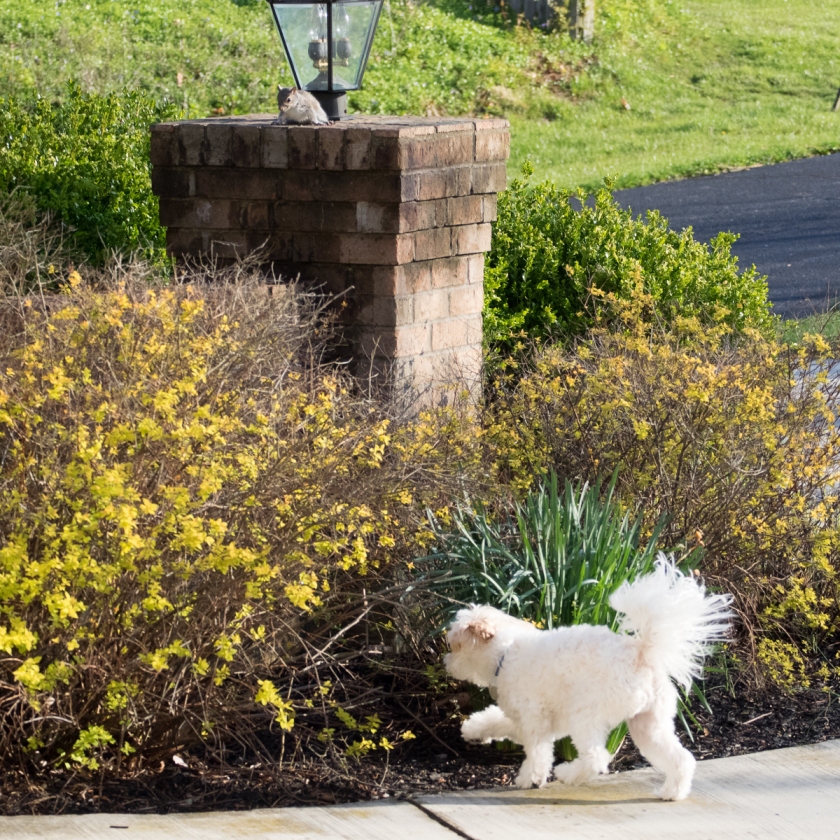
This clearly wasn’t good enough for Arthur. He was going in.
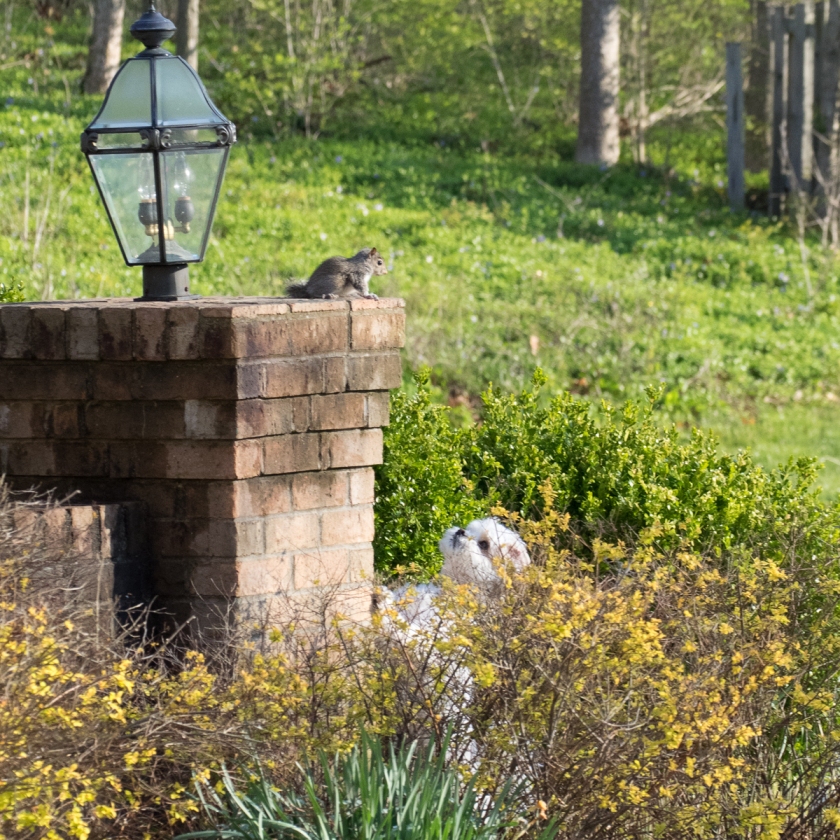
So close. Just not….quite….close….enough.
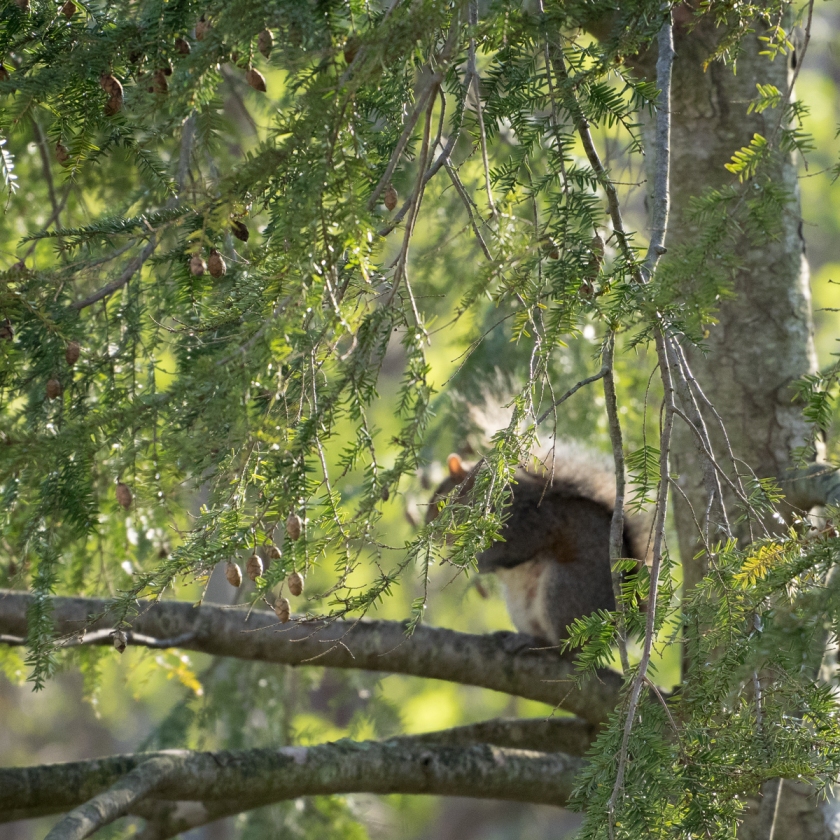
Meanwhile, the assumed parent squirrel could only wait and hope as he or she watched from a nearby tree.
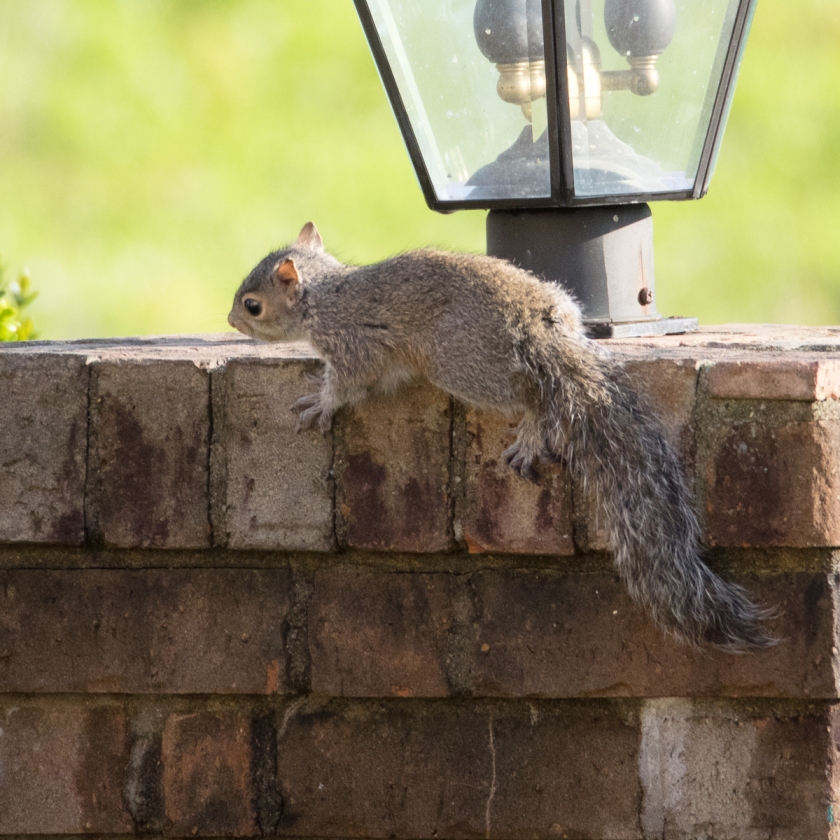
Arthur darted in and around the post trying to find a way to access the squirrel. Clearly this baby was terrified.
That’s enough, I thought. I’ve got to get Arthur away.
Easier said than done. There was no way this undisciplined little canine was going to come when I called. I was afraid to approach the squirrel for fear it would panic and get itself into a more vulnerable position. That was exactly what happened.
It jumped to the bushes, fell to the ground, back to the bushes, back on the post, then repeated with Arthur inches behind it. Finally the squirrel gave up on the post and tried to make a run for it. Arthur chased it behind the bushes beside the house. The squirrel passed by a tree that could have saved it, and continued on to the porch with Arthur and me, my camera dangling from the strap around my neck, in hot pursuit.
Arthur had the little guy cornered against the wall of the porch. And I could see all the games we played with his toy squirrel had trained him well for the darting, pawing, and biting he was attempting.
I didn’t think, but merely reacted when it looked like Arthur had his prey. I lunged for Arthur and landed full force on my bad knee on the cold hard concrete, banging the lens of my camera against the concrete in the process. But I bought the squirrel enough time to make it to the boxwood bushes where the chase continued. I watched helplessly, sitting on the cold concrete, yelling for Mark.
Mark came and had no better luck than I at grabbing Arthur, but much better luck at not injuring himself during the chase. Finally, the little squirrel jumped to the tulip tree at the corner of the house and achieved relative safety. Mark helped me up and eventually managed to lure Arthur away from the hunt with pieces of cooked chicken.
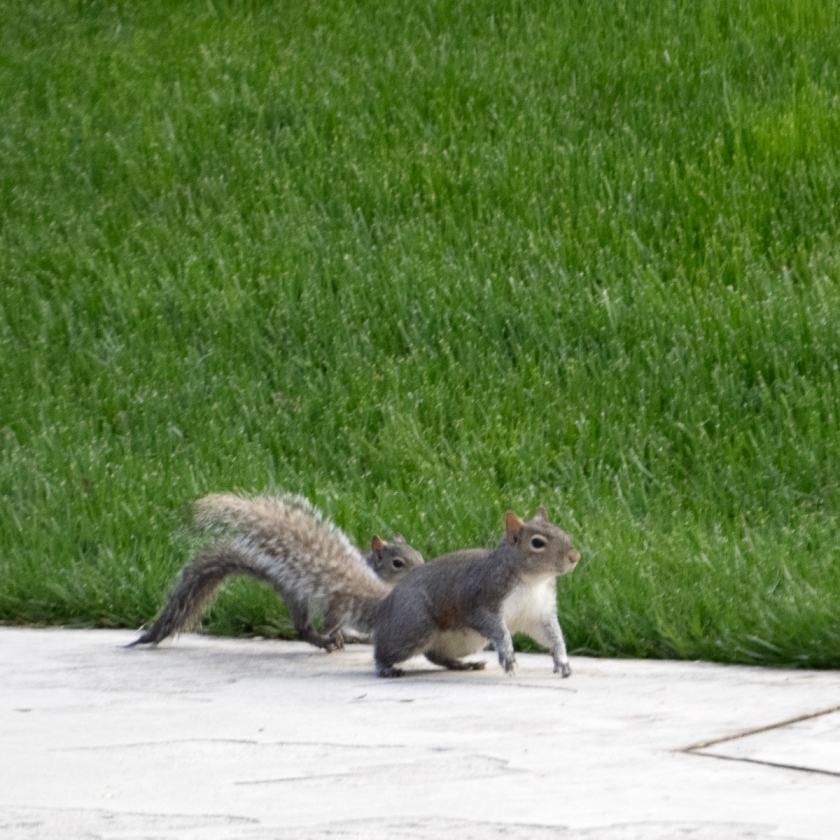
I didn’t know if Arthur had injured the baby squirrel until I saw it a few minutes later with the parent.

Baby looked fine as far as I could see. Arthur was never thanked by the squirrels for his role in the valuable lesson in vigilance, awareness, and evasion. And I will be icing my knee today.
